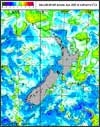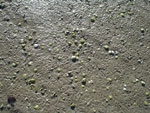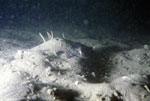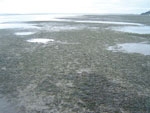PDF of this article (267 KB)






In looking at biodiversity, marine ecologists at NIWA have compared seagrass meadows and patches with nearby unvegetated areas. Judi Hewitt answers some of the questions that have guided the research.
At many places in our country, people are grappling with the multiple ways that New Zealanders use coastal areas. They are trying to balance uses with protection, and, in some cases, restoration. Seagrass meadows are often singled out as a habitat that should be protected, with the idea that a more diverse and different array of animals live within them than on surrounding non-vegetated areas. But much of the basis to this thinking is derived from overseas research, and there are some significant differences between seagrass here and overseas. In New Zealand, more of our seagrass is intertidal than subtidal, it is shorter in length, and it is primarily one species, Zostera capricorni. To examine the contribution of seagrass meadows in New Zealand, our recent research has posed a series of questions.
Are seagrass communities more diverse than those of surrounding bare sediments?
We’ve collected samples of benthic macrofauna (see below for definitions) within and outside of seagrass meadows and patches in a number of places in the North Island. We’ve sampled intertidally at Manukau, Whangapoua, Wharekawa, Whangamata, Kaipara, and Snells Beach, and subtidally in Kaipara, Slipper Island, and the Mercury Islands. This research has shown that there is no definite answer: in some areas seagrass habitats have higher numbers of species than surrounding sediments, in some areas they don’t. Also the answer varies within a location (for example, within Whangapoua Harbour) and with years and seasons. So, seagrass communities are not necessarily more diverse.
Does seagrass provide a unique habitat?
In other words, are the communities of a seagrass meadow or patch the same, regardless of which harbour they are located in? Again, research shows that the answer is ‘no’. While the communities of seagrass habitats can be different from the surrounding communities, they are usually more similar to the surrounding communities than they are to the community from seagrass in another place – even a different arm of the same harbour.
However, if the seagrass is growing in a sandy area, several varieties of crabs are more likely to be found inside than in surrounding bare sediments. Conversely, the New Zealand cockle is often found in higher densities outside seagrass beds.
Are seagrass beds uniquely important for birds and fish?
Birds use intertidal areas – seagrass as well as unvegetated areas of mud and sand flats – for foraging while the tide is out. Intertidal seagrass provides hiding places and food for juvenile fish while the tide is in (see previous article: Comparing seagrass meadows across New Zealand. But other areas also provide food and shelter; these include mangroves and unvegetated mud and sand flats, especially areas of shellfish, tube worm mats, burrows, and mounds. In subtidal areas, there are even more habitats that fish can use, including shellfish beds, rubble patches, and sponge gardens.
Does this mean that seagrass beds are not important in coastal areas?
No. Marine systems support biodiversity by providing a variety of habitats and communities for different plants, animals, and birds to live in and use.
A healthy system is a diverse system
A single estuary can contain a range of habitats: wetlands, nonvegetated and vegetated (mangroves and seagrass) intertidal flats, subtidal areas, and areas of differing sediment types. Even within a habitat type, bare sandflats, for example, a number of different benthic macrofaunal communities will be found – in a healthy system.
As a system becomes more and more dominated by one habitat type, and especially one community type, it will generally become less able to provide the variety of services – food, shelter, nursery grounds – needed by other organisms (including humans). Our research continues, focusing on the services provided by different habitats and how these services are put at risk by destruction of habitats within an estuary, harbour, or coastal area.
Terminology
Benthic macrofauna – animals (fauna) that live in or on the seabed or shore; ‘macro’ (large) refers to animals 0.5 mm to 100 mm across. Communities – similar to human communities, benthic communities are comprised of the animals that live together in a certain location or habitat. Intertidal – the region on the shore that’s exposed at low tide and covered at high tide. Subtidal – the region at the shore that’s always underwater.
Doing its bit for biodiversity
- Benthic communities in seagrass are not necessarily more diverse than surrounding non-vegetated areas.
- Seagrass is still important because it contributes to habitat diversity.
- A range of habitats provides the necessary variety of ‘services’ – such as food, shelter, and nursery grounds.
Dr Judi Hewitt is a marine benthic ecologist based at NIWA in Hamilton. This article summarises work by a number of people and organisations, including Kristel van Houte-Howes at NIWA and Dr Conrad Pilditch at the University of Waikato.
Teachers’ resource for NCEA Achievement Standards or Unit Standards: Biology Level 1 US6294, AS90162, AS90164, Level 2 AS90460 See other curriculum connections at www.niwa.co.nz/pubs/wa/resources
